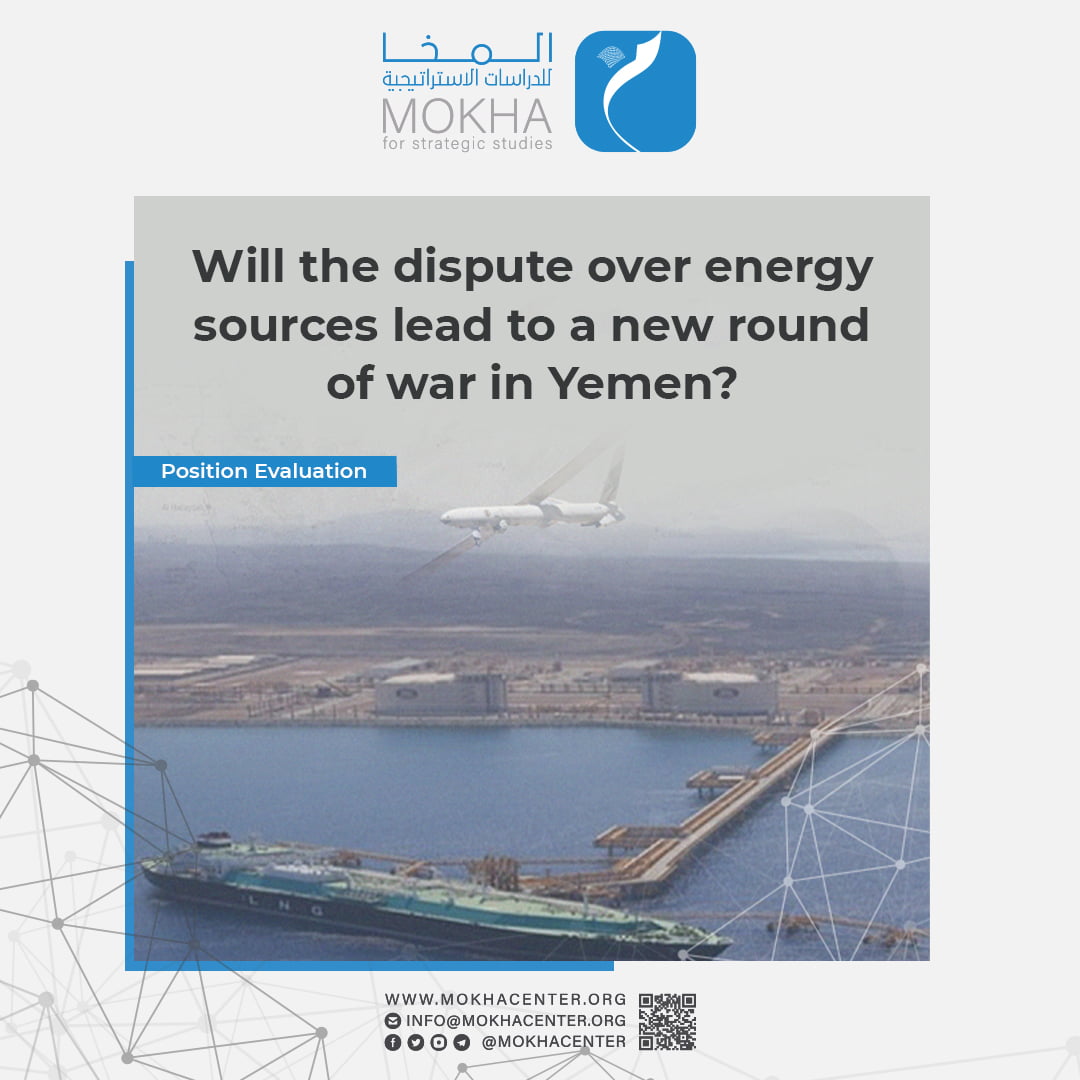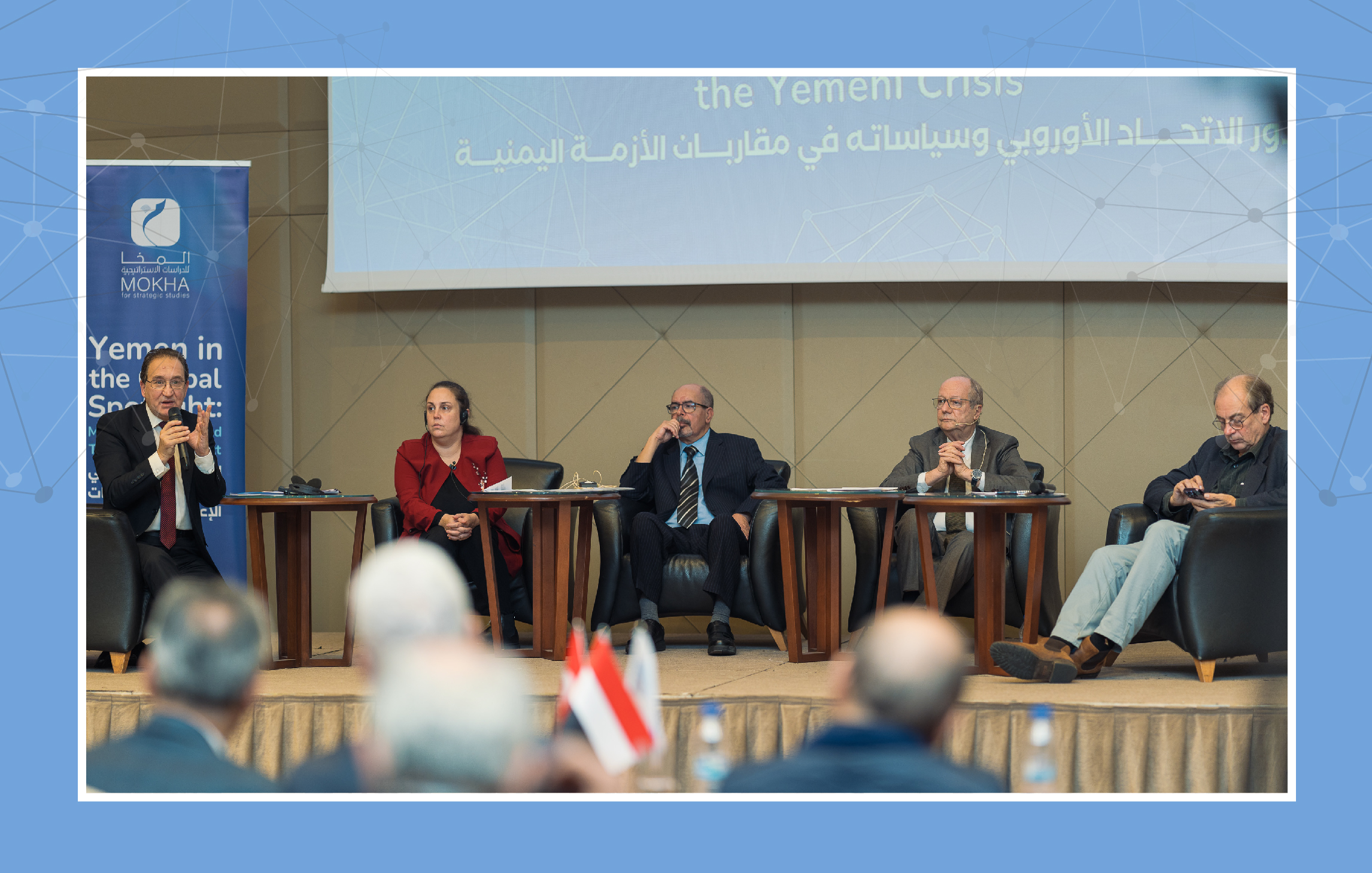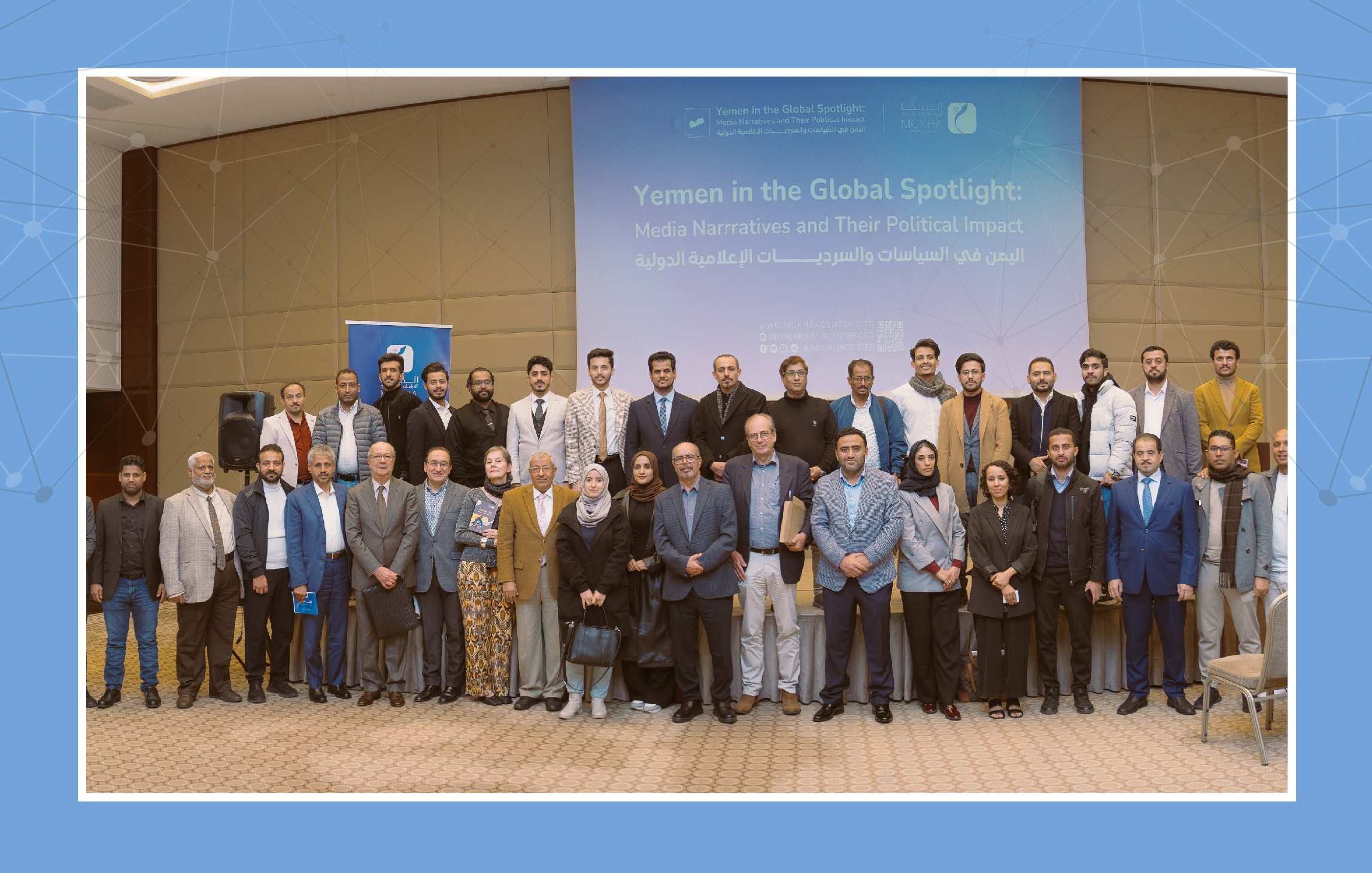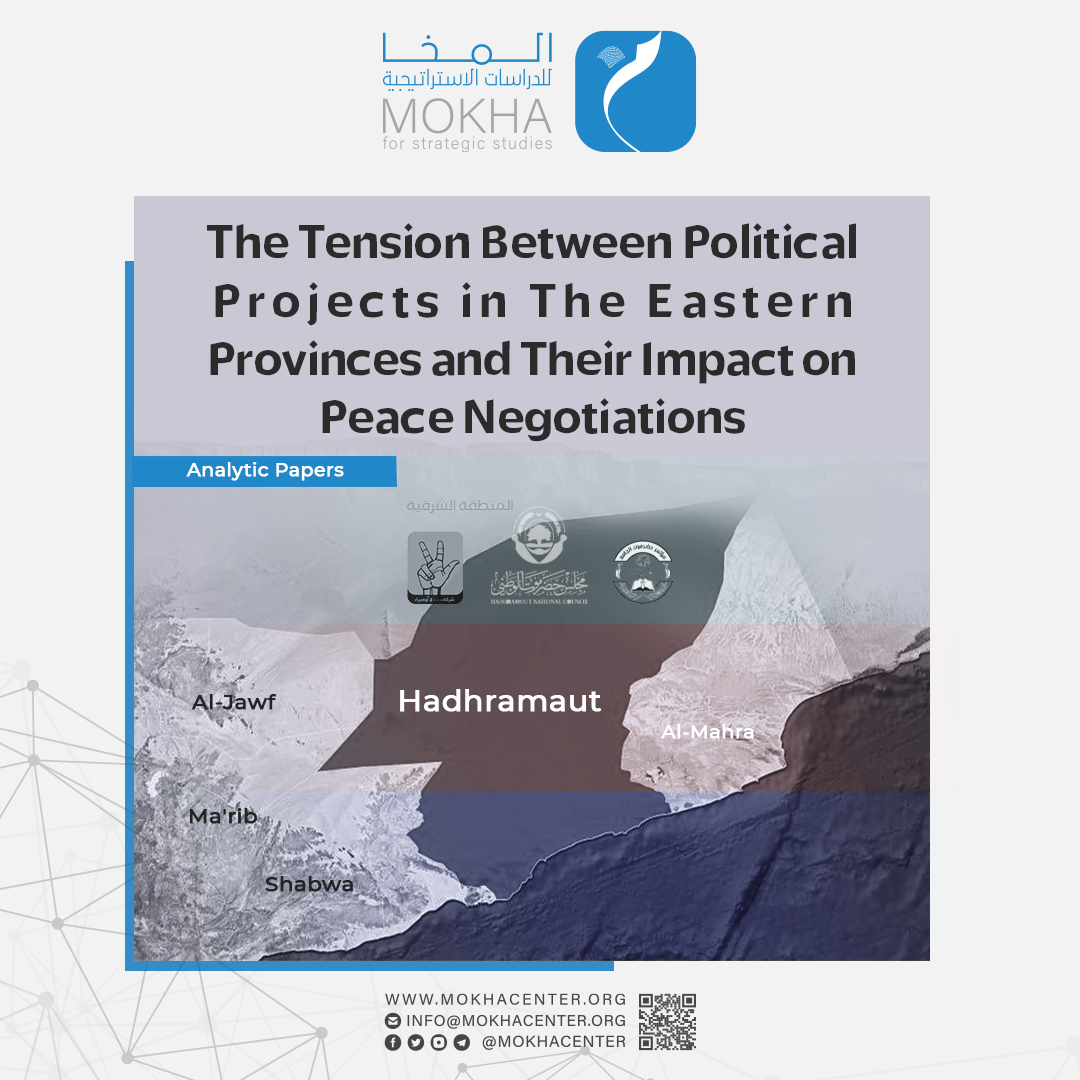Will the dispute over energy sources lead to a new round of war in Yemen?

| Getting your Trinity Audio player ready... |
On October 21, 2022, the Houthis launched drone and missile attacks on the Dabba oil port in Hadhramaut, while a ship was docking to load crude oil from the port. According to the Yemeni government statement, this is the second attack, as the Houthis had previously targeted the Radhum Petroleum Port, with two successive attacks, on the night of October 18, 2022.1
This escalation provoked the reaction of the National Defense Council, which then declared the Houthis a terrorist organization. This incident raised several questions: Will we witness a new round of conflict over energy sources? What are the possible repercussions of the Houthis’ attack on oil ports? What is the course of developments in Yemen and the region?
Limited Oil Resources:
Yemen produces limited quantities of oil and has limited oil reserves that do not exceed 4 billion barrels, some of which has been consumed. According to various sources, it is expected that the reserves will not last more than nine years, as production from oil fields has begun to decline, and the government’s share of the quantities of crude oil production has witnessed a continuous yearly reduction, reaching 6.5% annually on average, during the period from 2001 to 2014. Furthermore, considering the proven reserves, it is expected that the decline will increase in the future.2
However, the Yemeni economy is highly dependent on oil exports; the income from oil production constitutes 70% to 75% of government revenues and 90% of total exports3. Moreover, oil and gas revenues are the most important sources of hard currency inflow that feed foreign reserves of foreign exchange, finance imports of goods and support exchange rate stability.4
Gas:
Yemen began exporting liquefied natural gas in 2009. The total production capacity of the project is 6.7 million metric tons annually. However, the revenues from the gas exportation are not large, as they represented about 6.9% and 5.1% of the total revenues of the state’s general budget5. This is due to the fact that part of the proceeds goes to cover the large investment cost of establishing the gas liquefaction project in the port of Balhaf, which cost approximately $5 billion, and to distribute the proceeds of the sale among several foreign investment companies contributing to the establishment of the Yemeni Liquefied Natural Gas Company (YLNG)6, which is overseeing the project.
In 2005, the Yemen Liquefied Natural Gas Company signed 20-year sales agreements with three major companies: Kogas, GDF Suez and French Total, at predetermined prices. The price of gas was sold to Total at $1 per million thermal units, and to the Korean company, Kogas at $3.15 per million thermal units, while the prices at the time ranged between $11 and $12 per million thermal units. In 2014, the Yemeni government was able to adjust gas prices with the Korean company, Kogas, to $14 per million thermal units, which was rejected by Total, despite the engagement of the Yemeni government in multiple negotiations with it before gas exportation stopped in 2015.7
Effect of war:
The Arab coalition’s military operations, which began on March 26, 2015, led to the cessation of oil and gas production. Foreign companies evacuated their employees from Yemen, and the quantity of crude oil production and liquefied natural gas exports decreased by 67.8% and 80.3%, respectively, in 2015 as compared to 2014.
Furthermore, Aden Refinery stopped refining oil, while the Ma’rib Refinery production decreased by 4.8%, and the quantities of petroleum derivatives imports decreased by 65.3%, which led to a scarcity of fuel supply in the local market8. As a result, Yemen suffered from a severe crisis in oil derivatives and household gas.
As of August 2016, the Yemeni government resumed oil production and exportation from the Masila fields in Hadhramaut, where it was exported via the port of Ash-Shihr and the Rodom/Nashima station in Shabwa. However, production of oil in Shabwa and Safer fields in Ma’rib remain suspended, due to the presence of the pipeline, which transports oil to Hodeidah, in the Houthi-controlled areas.
The exportation of liquefied gas from the Safer fields through the port of Balhaf in Shabwa was suspended, due to the absence of security and the conversion of the port into a military barracks for the Emirati forces, which refuses to withdraw from it. Most likely, the insistence of Shabwa’s former governor to take back the Balhaf facility and to export gas, was one of the main reasons for his dismissal, after pressure was exerted by Abu Dhabi on the former president, Abdo Rabbo Mansour Hadi.
According to reports issued by the Central Bank of Yemen, Yemen’s revenues from crude oil exports increased in 2021, reaching $1.418 billion, compared to $710.5 million in the previous year, due to the increase in the Yemeni government’s share of the total value of oil exports to 75.1% in 2021, as compared to 60.3% in 2020, in addition to the rise in oil prices globally in the second half of last year.9
The growing interest in the energy file:
The recent period has witnessed an increase in the presence of energy exporters (oil and gas) in the political and media confrontations between the conflicting parties in Yemen, where several factors contributed to this, including:
- The global energy crisis:
The world has witnessed an energy crisis, with fuel prices rising worldwide due to the revitalization of global economies after lifting the restrictions to limit the spread of the COVID-19 pandemic. Furthermore, the Russian-Ukrainian war and the sanctions imposed by Western countries on Russia led to the emergence of a major crisis in energy resources, where oil prices increased to more than $120 per barrel, before settling at $90. As gas prices increased several times in many European countries, international powers turned to search for alternatives for Russian gas, where talks about Yemeni gas have been revived during visits and meetings between regional and international parties.
- The position of the Yemeni government to raise oil production:
In January 2020, the government announced a new plan to increase oil production, to about 80,000 barrels per day and to allow foreign exploration companies to resume their activity after it had been stopped during the past five years along with American companies, which have already expressed their willingness to start exploring operations10. This sparked the interest of the Houthis and generated the motivation to share these resources with the “Presidential Council” and apply political and media pressure under various banners: paying employee salaries, preventing looting of national wealth and sharing resources.
- Discussions about renewing the armistice:
The salary payment file was among the top topics, as it was discussed during the meetings and the discussions regarding the extension of the armistice, which put the energy file under the spotlight on the pretext that it is a financing source for those salaries.
- Pressure from international mediators:
Most of the proposals made by international mediators point to the need to direct the proceeds from the sale of oil and gas to pay the salaries of employees through the resource-sharing formula. It has been observed that the focus of intermediaries on the salary payment mechanism has shifted from a mechanism known as the “Stockholm Convention” to talking about the “resource sharing” formula.
Houthis’ escalation:
With the failure of efforts to extend the armistice, the Houthis threatened to target foreign oil companies in the areas under the control of the Yemeni government, giving them a deadline to stop oil extraction operations. These threats extended to the countries of the alliance as the Houthis announced they would target the oil companies operating in the UAE and Saudi Arabia. on the October 4, the Houthis renewed their threats and called on investors in Saudi Arabia and the UAE to transfer their investments.
The Houthis’ threats to target oil facilities in Yemen were not taken seriously until October 21, 2022, when they announced what they described as warning strikes, to prevent an oil ship that was “trying to loot crude oil”, through the Dabba port, in Hadhramaut, after violating the decision to ban the export of Yemeni sovereign petroleum derivatives, according to a statement by the Houthis.
A statement12 by the so-called economic committee of the Houthis stated “any exportation of crude oil is prohibited …” and that they “sent messages to the ship Nation Kia, which were ignored. However, the ship left Yemeni territorial waters after the warning operation.”
Furthermore, a government statement confirmed the attacks by the Houthis, on October 21, 2022, on the Dabba oil port in Hadhramaut, while an oil cargo ship was docking. Previously, the Houthis targeted the Radhum Petroleum Port, with two successive drone attacks, on the nights of October 18 and 1913. The Ministry of Oil and Minerals announced that no lives were lost during the Houthi attacks, calling on oil companies to continue their activities, assuring there is coordination with shipping companies to secure the process of exporting crude oil and with the governmental institutions to take all necessary measures to secure the exportation process.14
The National Defense Council held an urgent meeting in the presence of the president and members of the PLC, heads of legislative, executive and advisory authorities and governors of Hadhramaut and Shabwa. The council warned that this terrorist escalation would release the Yemeni government of all obligations, including the Stockholm Agreement and the terms of the humanitarian truce.15
Furthermore, the council issued a resolution classifying the Houthis as a terrorist organization and directed the relevant authorities to complete the necessary procedures to implement the resolution and warning the entities and individuals who provide the Houthis with support, assistance, facilities or any form of cooperation.15
The Houthis’ response came through the Minister of Information, in its unrecognized government, that they would target any ship that enters Yemeni ports to transport oil. With this escalation, the atmosphere of war has returned, which calls for drawing possible scenarios for the developments of the situation in Yemen in light of the mutual escalation between the government and the Houthis.
Scenarios:
A full reading of the current scene indicates that things may range between three possible scenarios, the first of which goes to the possibility that the current pressures and the overall internal and external situations will result in a compromise that paves the way for a new armistice. The other two scenarios discuss the possibility of things moving toward a military escalation, differing in the level and the scope of that escalation.
The first scenario – An exchange of pressure cards:
This scenario comes from the fact that the conflicting parties are not willing to enter another round of war, where each side uses their cards to pressure toward achieving the largest possible gains from the armistice.
In this context, the Houthis’ warning attacks took advantage of the international community’s desire to impose a political truce at any cost, besides the high tension between the U.S. and Saudi Arabia.
On the other hand, the Presidential Council classified the Houthis as a terrorist organization, a card that the legitimate government avoided playing in the previous stages of the conflict.
The Presidential Council aims to pressure international mediators to bargain with the Houthis and prevent them from launching future attacks on the port, all in return for retracting their classification. The Presidential Council is aware of the great impact of this classification, as it closes the door of negotiations with the Houthis and pushes the situation toward a new round of war, which is something the Houthis are trying to avoid.
On the other hand, it puts the international parties in a difficult situation with the Houthis, pushing them to pressure the Houthis to stop threatening the safety of the ports and giving up their demands. This will pave the way for negotiations and may result in agreements related to the mechanism of delivering the salaries of employees and renewing the armistice, perhaps with broader content than before.
This scenario supports the desire of each party to reach a settlement that would enable it to arrange its situation and supports international pressures that try to avoid a new crisis in the world, in addition to the pressures that Saudi Arabia is subjected to in light of its tense relationship with the U.S. and the structural problems facing the Presidential Leadership Council.
The second scenario – Escalation of violence:
This scenario tends to the fact that the Houthis’ wrong reading of the internal, regional and international situations will push them to escalate and refuse to make any concession considering their demands regarding the payment of salaries to the military formations affiliated with them, where this will strengthen their position before their bases as they prevented the ship from re-entering the port.
What’s more, this will force the PLC to meet this escalation similarly, especially since the conflict is related to energy sources, which is vital for the PLC, as oil revenues are the main source that enables the PLC to manage the situation in the areas under its control, and, to a greater extent, it enables it to pay the salaries of state officials. In general, the conditions may push the two sides toward a new round of confrontations, and it may be more violent than the previous rounds.
The occurrence of this scenario is supported by the euphoric state of the Houthis and their reading of the international situation. Furthermore, this may happen based on an American or Western green light to punish Saudi Arabia to drain it from security. The occurrence of this scenario is also supported by the popular pressures on the PLC toward the military response to the Houthis’ provocations.
The third scenario – The widening of the conflict:
This scenario is close to the previous one in many aspects. However, the escalation is likely to be greater due to the threats made by the Houthis, which we mentioned earlier, which could extend beyond Yemen to Saudi Arabia and perhaps the UAE. Shiite groups from Iraq and other parts of the region are expected to be involved, and we may witness Iranian involvement directly or through its tools in the region.
References
The Yemeni government: All options are open to deal with the Houthi terrorist attack on the port of Al-Daba, Saba Net (the website of the Yemeni news agency affiliated with legitimacy), available at the following link: https://shortest.link/5VCA
Bulletin of Economic and Social Developments in Yemen, Ministry of Planning and International Cooperation, Economic Studies and Forecasts Sector, Issue (12), March 2016, available at the following link: https://shortest.link/64Vd
History of Oil and Gas in Yemen, Safer Company website, available at the following link: https://shortest.link/678j
Bulletin of Economic and Social Developments in Yemen, Ministry of Planning and International Cooperation, Economic Studies and Forecasts Sector, Issue (14), May 2016, available at the following link: https://shortest.link/6aML
Gas export conflict. Another war renewed in Yemen, Al-Araby Al-Jadeed, on 10/17/2022, available at the following link: https://shortest.link/6np4
The company includes foreign investment companies: Total, which is the project manager (39.62%), Hunt Oil Company (17.22%), S .k Corporation (9.55%), Korea Gas Corporation (6.00%), Hyundai Gas Company (6.00%), Yemen Gas Company (16.37%), and the General Authority for Insurance and Pensions (5.00%).
Yemen raises gas prices for French Total (85%), Al-Araby Al-Jadeed, on 8/5/2014, available at the following link: https://shortest.link/654M
The previous reference. Yemen’s oil revenues double to $1.4 billion in 2021, Al-Arabiya Net, on 2/5/2022, available at the following link: https://shortest.link/64-L
The Yemeni government pledges to raise its oil production… Will the UAE allow it to export, Al Jazeera Net, on 5/1/2020, available at the following link: https://shortest.link/6mRD
The Houthis warn investors in the UAE and Saudi Arabia, Al-Mahriah TV, on 5/10/2022, available at the following link: https://almahriah.net/local/23028
The armed forces announced the implementation of a warning strike to prevent a ship that was trying to loot crude oil through the port of Al-Daba, Saba News Agency website (controlled by the Houthis), on 10/21/2022, available at the following link: https://www.saba. ye/en/video168
The Yemeni government: All options are open to deal with the Houthi terrorist attack on the port of Al-Daba, Saba Net (the website of the Yemeni News Agency), on 10/21/2022, available at the following link: https://shortest.link/5VCA
The National Defense Council holds an emergency meeting chaired by the President of the Presidential Council of Command, Saba Net (Yemen News Agency website), on October 22, 2022, available at the following link: https://www.sabanew.net/story/ar/91306
The National Defense Council classifies the Houthi militia as a terrorist organization and warns against dealing with it, Saba Net (Yemen News Agency website), on October 22, 2022, available at the following link: https://www.sabanew.net/story/ar/91308



